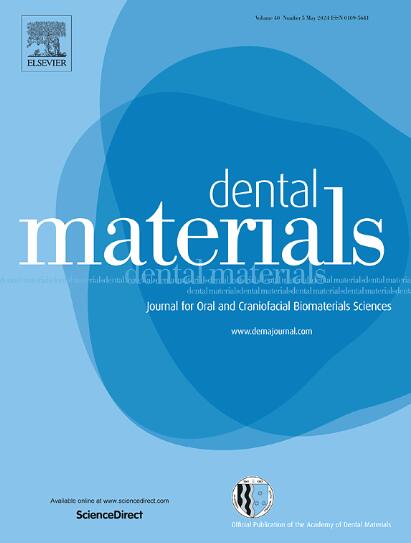Heating of dental composites: The crucial role of the silane coupling agent on the consistency change
IF 6.3
1区 医学
Q1 DENTISTRY, ORAL SURGERY & MEDICINE
引用次数: 0
Abstract
Objective
To evaluate the influence of the nature of silane coupling agents on the consistency of dental composites at various temperatures.
Methods
Silanes SI 1–4 were synthesized in one single step. They were characterized by 1H and 13C NMR spectroscopy. SI 1–4, as well as 3-methacryloyloxypropyltrimethoxysilane (MPTS), 8-methacryloyloxyoctyltrimethoxysilane (MOTS) and n-dodecyltrimethoxysilane were then used to functionalize a barium aluminum borosilicate glass filler (d50 = 1.0 µm). Silanizations were carried out in cyclohexane in the presence of a catalytic amount of n-propylamine. Each silane was used in an equimolar amount. Composites containing 67 wt% of silanized fillers and packable composites exhibiting a similar consistency at room temperature were subsequently formulated. The consistency of the uncured composites was determined at various temperatures (23 °C, 30 °C, 50 °C and 60 °C) using a texture analyzer. The flexural strength and modulus of the cured composites were assessed according to ISO 4049.
Results
The structure of the silane was shown to strongly influence the consistency of composites. The spacer length between silyl and methacrylate groups, as well as the presence of a urea or a urethane moiety, were demonstrated to be key parameters. Heating of each composite resulted in a drop of the consistency. The decrease was however significantly stronger if coupling agents with long spacers were selected. Especially, the use of SI 3 provided a packable composite which exhibited a packable consistency at 30 °C and flowable consistency at 60 °C. Regarding mechanical properties, it was shown that the coupling agent must be able to copolymerize with the monomers of the organic matrix to obtain high flexural strength and modulus values. The silanization of glass fillers using silanes bearing a long spacer was shown to have an additional advantage: packable composites having a higher filler content, and consequently improved flexural modulus, can be formulated.
Significance
The use of filler particles functionalized with silanes containing long alkyl spacers between the silyl and methacrylate moiety is a promising strategy for the development of packable dental composites which exhibit good mechanical properties and a strong drop in consistency upon heating.
牙科复合材料的加热:硅烷偶联剂对稠度变化的关键作用。
目的:探讨硅烷偶联剂的性质对口腔复合材料在不同温度下稠度的影响。方法:一步合成硅烷SI 1-4。通过1H和13C NMR对其进行了表征。然后用SI 1-4、3-甲基丙烯酰氧基丙基三甲氧基硅烷(MPTS)、8-甲基丙烯酰氧基辛基三甲氧基硅烷(MOTS)和n-十二烷基三甲氧基硅烷功能化钡铝硼硅酸盐玻璃填料(d50 = 1.0 µm)。在催化量的正丙胺存在下,在环己烷中进行硅化反应。每种硅烷以等摩尔量使用。含有67 wt%硅化填料的复合材料和在室温下具有相似稠度的可包装复合材料随后被配制。在不同温度(23°C、30°C、50°C和60°C)下,使用织构分析仪测定未固化复合材料的稠度。根据ISO 4049对固化复合材料的抗弯强度和模量进行了评定。结果:硅烷的结构对复合材料的稠度有很大影响。硅基和甲基丙烯酸基团之间的间隔长度以及尿素或氨基甲酸乙酯部分的存在被证明是关键参数。每种复合材料的加热导致稠度下降。然而,如果选择具有长间隔的偶联剂,则下降幅度明显更大。特别是,SI 3的使用提供了一种可包装的复合材料,在30°C时具有可包装的稠度,在60°C时具有可流动的稠度。在力学性能方面,偶联剂必须能够与有机基体的单体共聚,才能获得较高的抗弯强度和模量。使用硅烷承载长间隔的玻璃填料的硅烷化被证明具有额外的优势:可包装的复合材料具有更高的填料含量,从而改善弯曲模量,可以配制。意义:使用硅烷功能化的填充颗粒,在硅烷和甲基丙烯酸酯部分之间含有长烷基间隔物,是开发可包装牙科复合材料的一种很有前途的策略,这种复合材料具有良好的力学性能和加热后稠度的强烈下降。
本文章由计算机程序翻译,如有差异,请以英文原文为准。
求助全文
约1分钟内获得全文
求助全文
来源期刊

Dental Materials
工程技术-材料科学:生物材料
CiteScore
9.80
自引率
10.00%
发文量
290
审稿时长
67 days
期刊介绍:
Dental Materials publishes original research, review articles, and short communications.
Academy of Dental Materials members click here to register for free access to Dental Materials online.
The principal aim of Dental Materials is to promote rapid communication of scientific information between academia, industry, and the dental practitioner. Original Manuscripts on clinical and laboratory research of basic and applied character which focus on the properties or performance of dental materials or the reaction of host tissues to materials are given priority publication. Other acceptable topics include application technology in clinical dentistry and dental laboratory technology.
Comprehensive reviews and editorial commentaries on pertinent subjects will be considered.
 求助内容:
求助内容: 应助结果提醒方式:
应助结果提醒方式:


